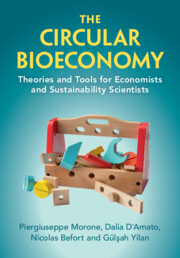Book contents
- The Circular Bioeconomy
- The Circular Bioeconomy
- Copyright page
- Contents
- Figures
- Tables
- Preface
- Acknowledgements
- Note on the Text
- Abbreviations and Notations
- Part I
- Part II
- 4 Environmental Economics and the Bioeconomy
- 5 Sustainability Transition and the Bioeconomy
- 6 The Role of Bioeconomy towards Safe and Just Sustainability Transformations
- Part III
- Index
- References
5 - Sustainability Transition and the Bioeconomy
from Part II
Published online by Cambridge University Press: 26 October 2023
- The Circular Bioeconomy
- The Circular Bioeconomy
- Copyright page
- Contents
- Figures
- Tables
- Preface
- Acknowledgements
- Note on the Text
- Abbreviations and Notations
- Part I
- Part II
- 4 Environmental Economics and the Bioeconomy
- 5 Sustainability Transition and the Bioeconomy
- 6 The Role of Bioeconomy towards Safe and Just Sustainability Transformations
- Part III
- Index
- References
Summary
Our objective in this chapter is to elaborate on the concepts of transition and paradigm shift and further discuss the concept of sustainability transition. We applied the transition theory proposed by Geels (2010) to the case of bioeconomy. This theory proposes a multi-level perspective for framing socio-technical sustainability transitions. The chapter identifies dynamics and actors involved in the purposive sustainability transition at a micro (e.g., pilot projects, emerging technologies), meso (e.g., leading sectors and industries), and macro (global social, economic, and environmental drivers) levels.
- Type
- Chapter
- Information
- The Circular BioeconomyTheories and Tools for Economists and Sustainability Scientists, pp. 86 - 106Publisher: Cambridge University PressPrint publication year: 2023



